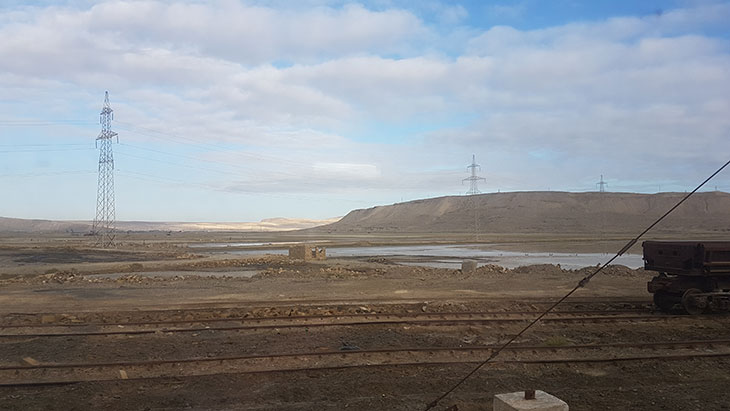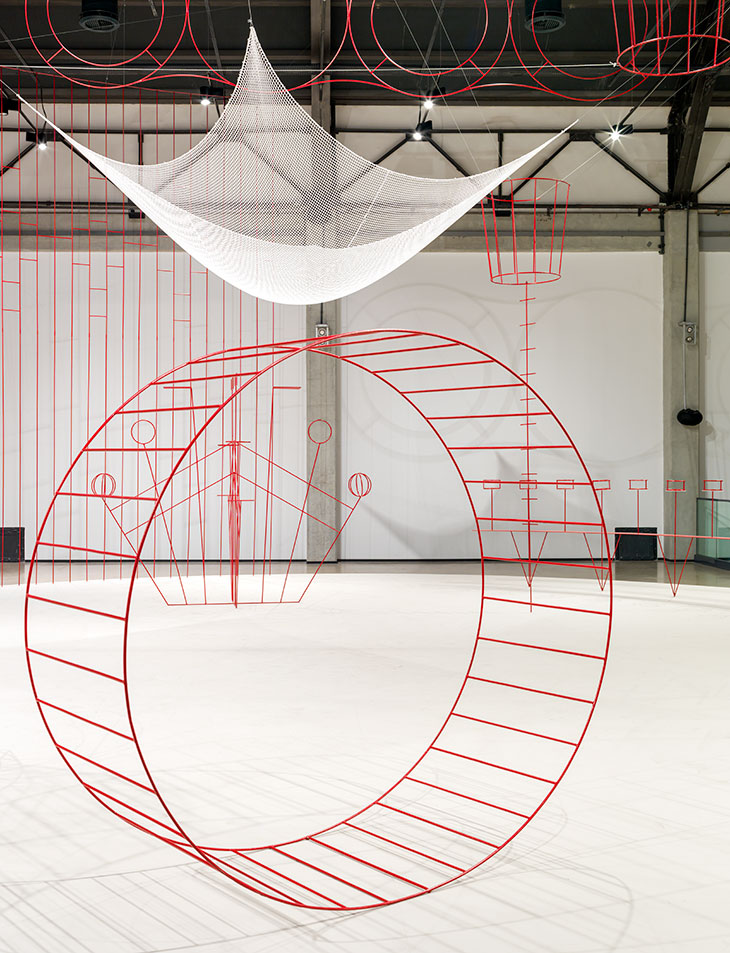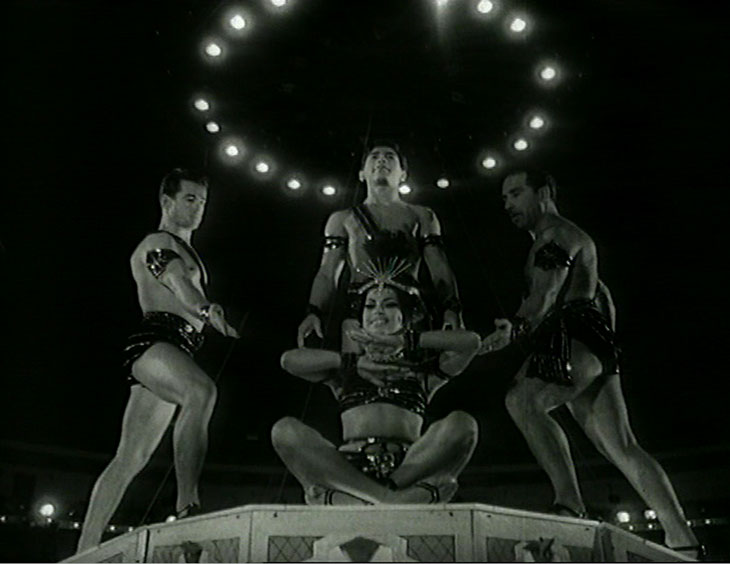Baku comes as a surprise when arriving by train. For hours you see nothing but bare earth studded with the odd pylon or nodding donkey. The landscape appears endlessly malleable, like the sandpit of some unruly giant. Then suddenly, glass towers begin to sprout on the horizon in an array of improbable shapes. Is this really Baku, or a mirage in the desert?
Even the locals can’t believe their own eyes. On the seafront flies a huge national flag the size of two tennis courts. As you might imagine, it’s one of the more visible features of the city. ‘A taxi driver told me that the flag was actually a projection or a digital simulation,’ the artist Taus Makhacheva tells me over Skype. ‘This myth-making is so symptomatic of the Caucasus.’

The desert outside Baku, 2019. Photo: the author
Born in Moscow, Makhacheva traces her origins to Dagestan, the Russian federal republic that borders Azerbaijan to the north. Much of her work, which spans performance, video and installation, deals with vexed questions of identity in the post-Soviet Caucasus, often approached through a lens of humour. In Tightrope (2015), the film that brought Makhacheva to international prominence at the Venice Biennale in 2017, a tightrope walker crosses a ravine while carrying artworks from the Dagestan Museum of Fine Arts. It is hardly surprising that an artist who is so fascinated by precarity and illusion should have revisited circus arts in ‘Charivari’, her exhibition at Yarat Contemporary Art Centre in Baku (12 July–29 September).
‘Charivari’ is housed in Yarat’s cavernous exhibition space, a former Soviet naval building overlooking the Caspian Sea. This feels appropriate, as ostensibly, the exhibition – whose title refers to the culminating ensemble sequence in a circus routine – is about the Soviet circus. In the Soviet Union, the circus was endorsed as an art form for the proletariat. Narrative-driven routines served ideological aims, celebrating the space programme or glorifying war heroes. On international tours, the Moscow State Circus rivalled the Bolshoi Ballet as an instrument of soft power. Circuses in regional capitals such as Baku or Tashkent served another function: a way of expressing, through costume, dance and song, state-approved versions of the many national identities that the Soviet Union had subsumed. And yet it was a ‘really strange thing’, says Makhacheva. ‘On one hand it was created to affirm political ideology; on the other, it allowed a little bit more liberty than other art forms.’ Unlike say, socialist realist painting, which had to express a clear didactic message, the artful foolery of the circus arena opened up a space for irony and subversion that was rare in Soviet culture.

Installation view of ‘Taus Makhacheva: Charivari’ at Yarat Contemporary Art Centre, Baku, 2019. Photo: Pat Verbruggen; courtesy the artist and Yarat
But ‘Charivari’ is concerned with the present and future as much as the past. The exhibition is dominated by a monumental sculptural installation suggesting a life-size, empty circus arena: ‘a mix,’ says Makhacheva, ‘between a fossil and a dream’. Skeletal structures in red wrought iron rise from a raised dais. Some – ladders, hoops, a safety net – recall familiar societal metaphors. Others are more abstract: a cluster of figurative shapes might be a human pyramid as sketched by Malevich. A tower of teetering cylinders evokes the bold geometry of Constructivism but also, perhaps, one of the wackier starchitect creations crowding the Baku skyline today. To one side stands a set of empty costumes, fantastical or impossible to wear. A suit made of broken shards of mirror reflects the viewer into a thousand pieces.
The exhibition is brought to life by a series of monologues by writer Alexander Snegirev that boom from speakers on the wall (performed by actors in Russian, but available in English via headphones). First, a ringmaster welcomes us to the show. Then things turn darkly satirical. There’s a story about ‘synthetic circus bears’ who need ‘good treatment and a strong whip’. There are horses who eat one another, mothers who give birth in the sawdust, a paean to the nutritional qualities of oil. (Perhaps this one isn’t so absurd: the menu at my hotel offers steak ‘with its usual lubricants’. In Baku, oil seeps into everything.) ‘Using language, I think this the craziest and most transgressive work I’ve ever done,’ Makhacheva says.

Film still from the documentary National Circus (1967). Courtesy Krasnogorsk Film Archive
In recent years, the Azeri government has funnelled its oil profits into remodelling Baku in order to host international spectacles. Eurovision, the European Games, the Europa League Final: it isn’t hard to spot a theme. By throwing enough bread at circuses like these, the regime hopes to persuade the world that Azerbaijan has emerged from its post-Soviet chrysalis as a modern European nation. But even a brief visit exposes the hollowness of this ploy. On both days I am in Baku, traffic in the city centre grinds to a lengthy halt to make way for the presidential motorcade. A plaque in the Carpet Museum praises ‘the great leader, Mr Ilham Aliyev’. At airport security, my bag is pulled aside because it contains books.
It would be easy, then, to write off Yarat as just another tool in Azerbaijan’s soft power campaign. Yarat’s founder, the artist Aida Mahmudova, is the president’s niece, and the building that Yarat calls home was donated by the government in 2015. While art can undoubtedly be pressed into service as PR, a contemporary art gallery isn’t like a grand prix or a football match. It asks questions, provokes, invites thought and debate. Like the Soviet circus, it’s a space where meaning comes adrift in exciting and unpredictable ways. In Azerbaijan, which had no contemporary art scene to speak of before Yarat launched in 2011, this feels like a valuable thing. ‘I’m a very sincere believer in the art,’ Makhacheva says. ‘On its own wavelength, it can change a lot of things. And I think it’s important for people who are searching for that wavelength to be able to find it. And possibly form a very different future.’














![Masterpiece [Re]discovery 2022. Photo: Ben Fisher Photography, courtesy of Masterpiece London](http://zephr.apollo-magazine.com/wp-content/uploads/2022/07/MPL2022_4263.jpg)
‘Like landscape, his objects seem to breathe’: Gordon Baldwin (1932–2025)